Oldsmobile Alero 2003 Owner's Manuals
Manufacturer: OLDSMOBILE, Model Year: 2003, Model line: Alero, Model: Oldsmobile Alero 2003Pages: 354, PDF Size: 16.74 MB
Page 171 of 354
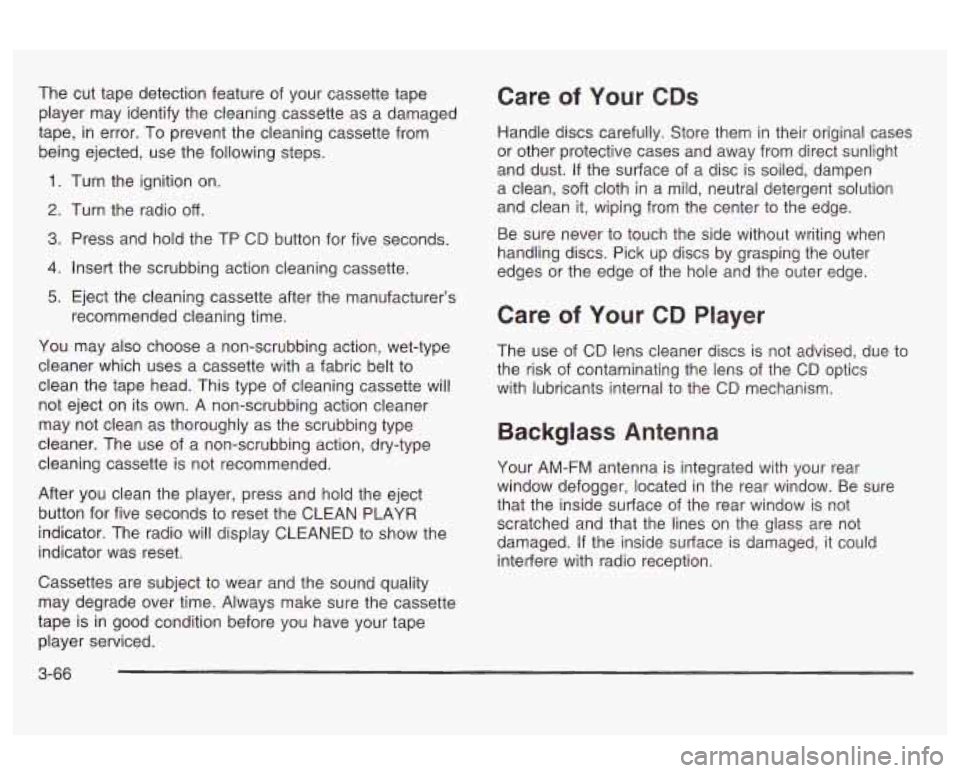
The cut tape detection feature of your cassette tape
player may identify the cleaning cassette as a damaged
tape, in error. To prevent the cleaning cassette from
being ejected, use the following steps.
1. Turn the ignition on.
2. Turn the radio off.
3. Press and hold the TP CD button for five seconds.
4. Insert the scrubbing action cleaning cassette.
5. Eject the cleaning cassette after the manufacturer’s
recommended cleaning time.
You may also choose a non-scrubbing action, wet-type
cleaner which uses a cassette with a fabric belt to
clean the tape head. This type
of cleaning cassette will
not eject on its own. A non-scrubbing action cleaner
may not clean as thoroughly as the scrubbing type
cleaner. The use of a non-scrubbing action, dry-type
cleaning cassette is not recommended.
After you clean the player, press and hold the eject
button for five seconds to reset the CLEAN PLAYR
indicator. The radio will display CLEANED to show the
indicator was reset.
Cassettes are subject to wear and the sound quality
may degrade over time. Always make sure the cassette
tape is in good condition before you have your tape
player serviced.
Care of Your CDs
Handle discs carefully. Store them in their original cases
or other protective cases and away from direct sunlight
and dust.
If the surface of a disc is soiled, dampen
a clean, soft cloth in a mild, neutral detergent solution
and clean
it, wiping from the center to the edge.
Be sure never to touch the side without writing when
handling discs. Pick up discs by grasping the outer
edges or the edge of the hole and the outer edge.
Care of Your CD Player
The use of CD lens cleaner discs is not advised, due to
the risk of contaminating the lens of the CD optics
with lubricants internal to the CD mechanism.
Backglass Antenna
Your AM-FM antenna is integrated with your rear
window defogger, located in the rear window. Be sure
that the inside surface of the rear window is not
scratched and that the lines on the glass are not
damaged.
If the inside surface is damaged, it could
interfere with radio reception.
3-66
Page 172 of 354
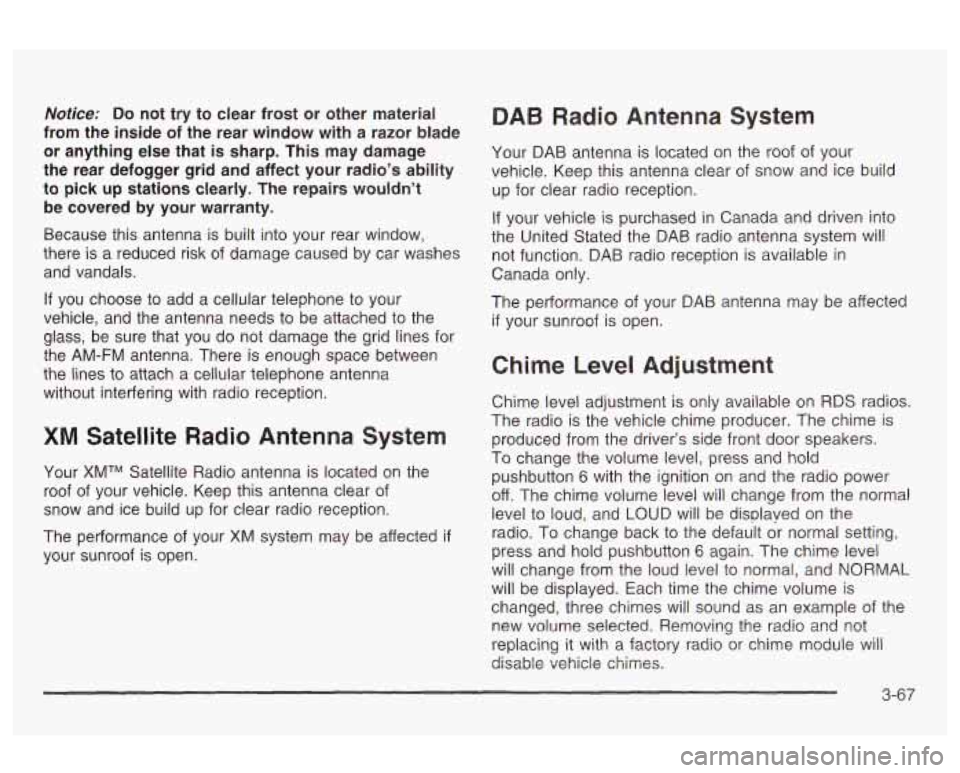
Notice; Do not try to clear frost or other material
from the inside
of the rear window with a razor blade
or anything else that
is sharp. This may damage
the rear defogger grid and affect your radio’s ability
to pick up stations clearly. The repairs wouldn’t
be covered by your warranty.
Because this antenna is built into your rear window,
there is a reduced risk of damage caused by car washes
and vandals.
If you choose to add a cellular telephone to your
vehicle, and the antenna needs to be attached to the
glass, be sure that you do not damage the grid lines for
the AM-FM antenna. There is enough space between
the lines to attach a cellular telephone antenna
without interfering with radio reception.
XM Satellite Radio Antenna System
Your XMTM Satellite Radio antenna is located on the
roof of your vehicle. Keep this antenna clear of
snow and ice build up for clear radio reception.
The performance of your
XM system may be affected if
your sunroof is open.
DAB Radio Antenna System
Your DAB antenna is located on the roof of your
vehicle. Keep this antenna clear of snow and ice build
up for clear radio reception.
If your vehicle is purchased in Canada and driven into
the United Stated the DAB radio antenna system will
not function. DAB radio reception is available in
Canada only.
The performance of your DAB antenna may be affected
if your sunroof is open.
Chime Level Adjustment
Chime level adjustment is only available on RDS radios.
The radio is the vehicle chime producer. The chime is
produced from the driver’s side front door speakers.
To change the volume level, press and hold
pushbutton 6 with the ignition on and the radio power
off. The chime volume level will change from the normal
level to loud, and
LOUD will be displaved on the
radio. To change back to the default or normal setting,
press and hold pushbutton
6 again. The chime level
will change from the loud level to normal, and
NORMAL
will be displayed. Each time the chime volume is
changed, three chimes will sound as an example of the
new volume selected.
Removing the radio and net
replacing it with a factory radio or chime module will
disable vehicle chimes.
3-67
Page 173 of 354

Page 174 of 354

Section 4 Driving Your Vehicle
Your Driving. the Road. and Your Vehicle .......... 4-2
Defensive Driving
........................................... 4.2
Drunken Driving
............................................. 4.2
Control of a Vehicle
........................................ 4-5
Braking
......................................................... 4-6
Enhanced Traction System
(ETS) ..................... 4-9
Steering
...................................................... 4-10
Off-Road Recovery
....................................... 4-12
Passing
....................................................... 4-13
Loss of Control
............................................. 4-14
Driving at Night
............................................ 4-15
Driving in Rain and on Wet Roads
.................. 4-17
City Driving
.................................................. 4.20 Freeway
Driving
.......................................... -4-21
Before Leaving on a Long Trip
....................... 4-22
Highway Hypnosis
....................................... -4-22
Hill and Mountain Roads
................................ 4-23
Winter Driving
.............................................. 4-25
If You Are Stuck: In Sand, Mud,
Ice or Snow
.............................................. 4-29
lowing Your Vehicle
..................................... 4-31
Recreational Vehicle lowing
........................... 4-31
Loading Your Vehicle
.................................... 4-34
lowing a Trailer
........................................ 4-36
Towing
.......................................................... 4-31
4- 1
Page 175 of 354
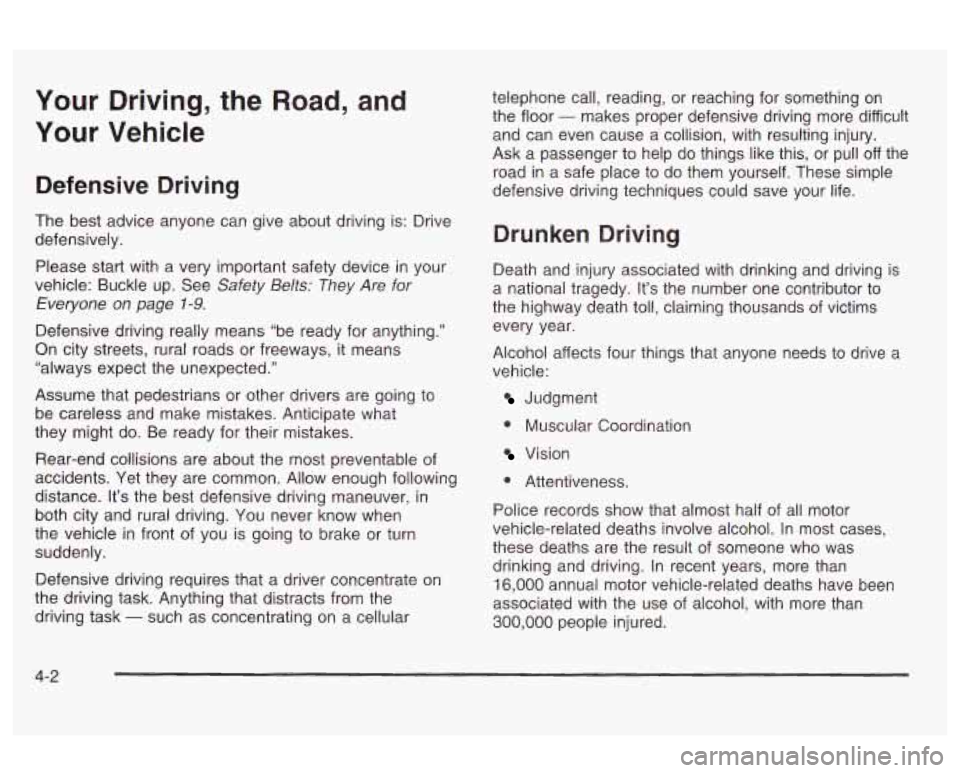
Your Driving, the Road, and
Your Vehicle
Defensive Driving
The best advice anyone can give about driving is: Drive
defensively.
Please start with a very important safety device in your
vehicle: Buckle up. See
Safety Belts: They Are for
Everyone on page
1-9.
Defensive driving really means “be ready for anything.”
On city streets, rural roads or freeways, it means
“always expect the unexpected.”
Assume that pedestrians or other drivers are going to
be careless and make mistakes. Anticipate what
they might do. Be ready for their mistakes.
Rear-end collisions are about the most preventable of
accidents. Yet they are common. Allow enough following
distance. It’s the best defensive driving maneuver, in
both city and rural driving. You never know when
the vehicle in front of you is going to brake or turn
suddenly.
Defensive driving requires that a driver concentrate on
the driving task. Anything that distracts from the
driving task
- such as concentrating on a cellular telephone call, reading,
or reaching for something on
the floor
- makes proper defensive driving more difficult
and can even cause a collision, with resulting injury.
Ask a passenger to help do things like this, or pull off the
road in a safe place to do them yourself. These simple
defensive driving techniques could save your life.
Drunken Driving
Death and injury associated with drinking and driving is
a national tragedy. It’s the number one contributor to
the highway death toll, claiming thousands of victims
every year.
Alcohol affects four things that anyone needs to drive a
vehicle:
Judgment
0 Muscular Coordination
Vision
0 Attentiveness.
Police records show that almost half of all motor
vehicle-related deaths involve alcohol. In most cases,
these deaths are the result of someone who was
drinking and driving.
In recent years, more than
16,000 annual motor vehicle-related deaths have been
associated with the use of alcohol, with more than
300,000 people injured.
4-2
Page 176 of 354
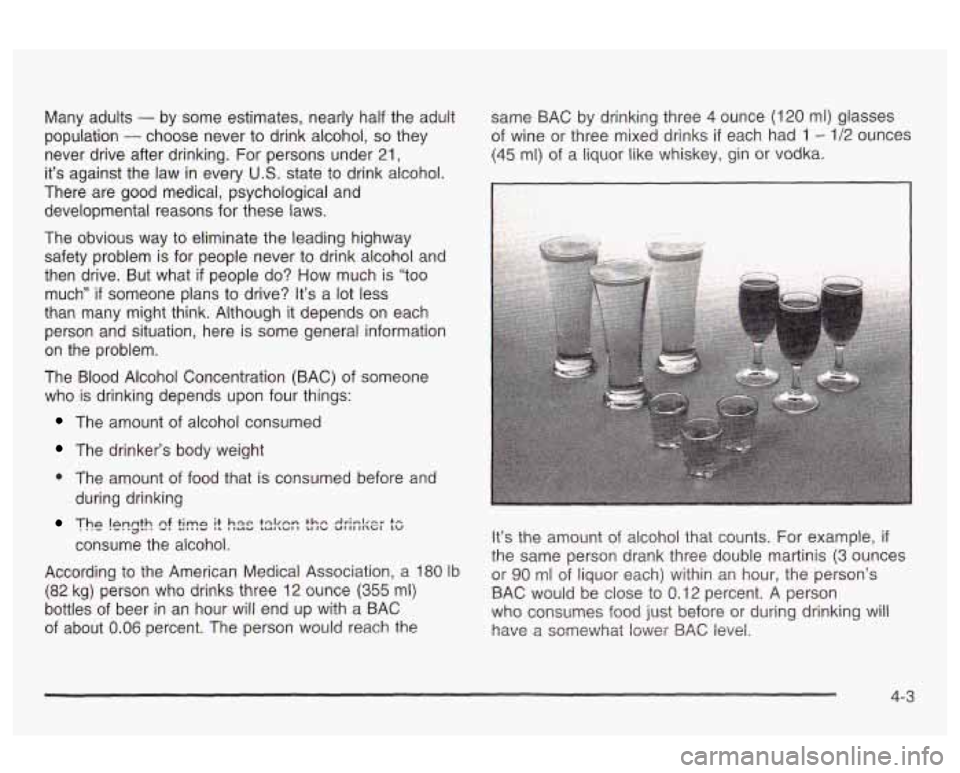
Many adults - by some estimates, nearly half the adult
population
- choose never to drink alcohol, so they
never drive after drinking. For persons under
21,
it’s against the law in every US. state to drink alcohol.
There are good medical, psychological and
developmental reasons for these laws.
The obvious way
to eliminate the leading highway
safety problem is for people never to drink alcohol ana
then drive. But what
if people do? How much is “too
much”
if someone plans to drive? It’s a lot less
than many might think. Although it depends on each
person and situation, here
is some general information
on the problem.
The Blood Alcohol Concentration (BAC) of someone
who
is drinking depends upon four things:
The amount of alcohol consumed
The drinker’s body weight
0 The amount of food that is consumed before and
during drinking
consume the alcohol.
The !P“”+h Y” * c!! time It hss t2:kc:: tbz drifiker :G
According to the American Medical Association, a 180 Ib
(82 kg) person who drinks three 12 ounce (355 ml)
bottles of beer in an hour will end up with a BAC
of about
0.06 percent. The person would reach the
same BAC by drinking three 4 ounce (120 ml) glasses
of wine or three mixed drinks
if each had 1 - 1/2 ounces
(45 ml) of a liquor like whiskey, gin or vodka.
I
It’s the amount of alcohol that counts. For example, if
the same person drank three double martinis (3 ounces
or
90 mi of liquor each) within an hour, the person’s
BAC would be close to
0.1 2 percent. A person
who consumes food just before or during drinking will
ha\le a s~mev~lciat Iwv~~ BAC ievei.
4-3
Page 177 of 354
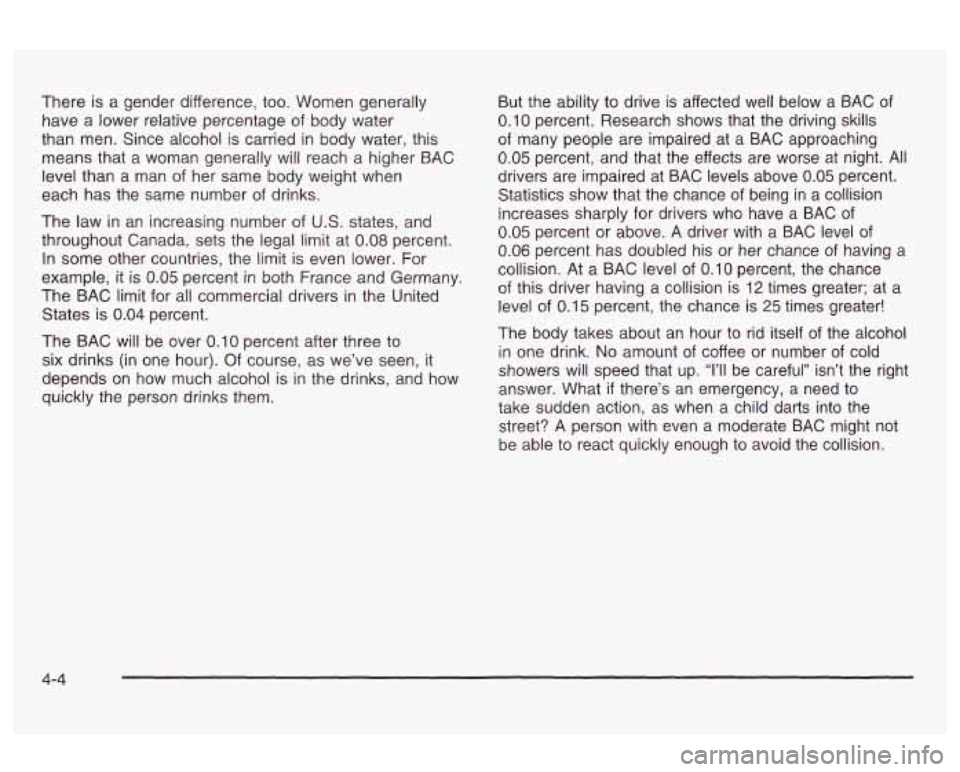
There is a gender difference, too. Women generally
have a lower relative percentage
of body water
than men. Since alcohol is carried in body water, this
means that a woman generally will reach a higher BAC
level than a man of her same body weight when
each has the same number of drinks.
The law in an increasing number
of U.S. states, and
throughout Canada, sets the legal limit at
0.08 percent.
In some other countries, the limit is even lower. For
example, it is
0.05 percent in both France and Germany.
The BAC limit for all commercial drivers in the United
States
is 0.04 percent.
The BAC will be over
0.10 percent after three to
six drinks (in one hour).
Of course, as we’ve seen, it
depends on how much alcohol is in the drinks, and how
quickly the person drinks them. But
the ability to drive
is affected well below a BAC of
0.10 percent. Research shows that the driving skills
of many people are impaired at a BAC approaching
0.05 percent, and that the effects are worse at night. All
drivers are impaired at BAC levels above
0.05 percent.
Statistics show that the chance of being in a collision
increases sharply for drivers who have a BAC
of
0.05 percent or above. A driver with a BAC level of
0.06 percent has doubled his or her chance of having a
collision. At a BAC level of
0.10 percent, the chance
of this driver having a collision is
12 times greater; at a
level of
0.15 percent, the chance is 25 times greater!
The body takes about an hour to rid itself of the alcohol
in one drink.
No amount of coffee or number of cold
showers will speed that up.
“1’11 be careful” isn’t the right
answer. What
if there’s an emergency, a need to
take sudden action, as when a child darts into the
street? A person with even a moderate BAC might not
be able to react quickly enough to avoid the collision.
4-4
Page 178 of 354
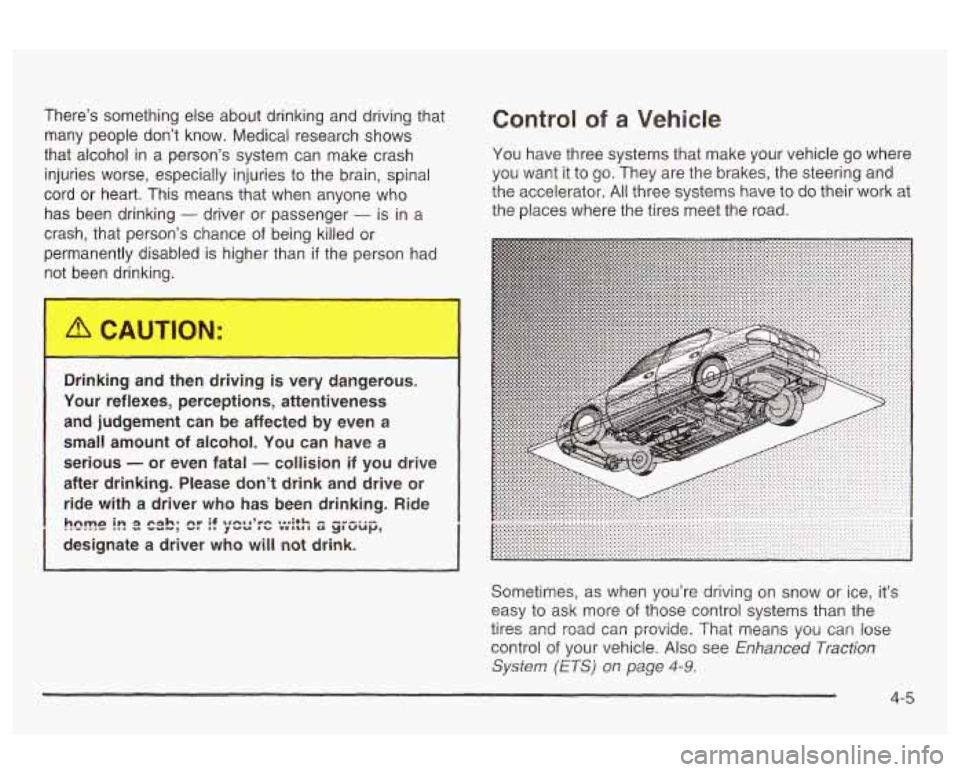
There’s something else about drinking and driving that
many people don’t know. Medical research shows
that alcohol in a person’s system can make crash
injuries worse, especially injuries to the brain, spinal
cord or heart. This means that when anyone who
has been drinking
- driver or passenger - is in a
crash, that person’s chance
of being killed or
permanently disabled is higher than
if the person had
not been drinking.
Control of a Vehicle
You have three systems that make your vehicle go where
you want it to go. They are the brakes, the steering and
the accelerator.
All three systems have to do their work at
the places where the tires meet the road.
I
,,inking and then driving is very dangerous.
Your reflexes, perceptions, attentiveness
and judgement can be affected by even
a
small amount of alcohol. You can have a
serious
- or even fatal - collision if you drive
after drinking. Please don’t drink and drive or
ride with a driver who has been drinking. Ride
designate
a driver who will not drink.
h~m~ i~ 8 cab; cr if agnma’mn ...;+I- - ----.- ~VU nb vw~wr a y~ VU~,
I
Sometimes, as when you’re driving on snow or ice, it’s
easy to ask more
of those control systems than the
control
of your vehicle. Also see Enhanced Traction
System (ETS) on page 4-9.
tires and :cad car: prwidz. That means you can lose
4-5
Page 179 of 354
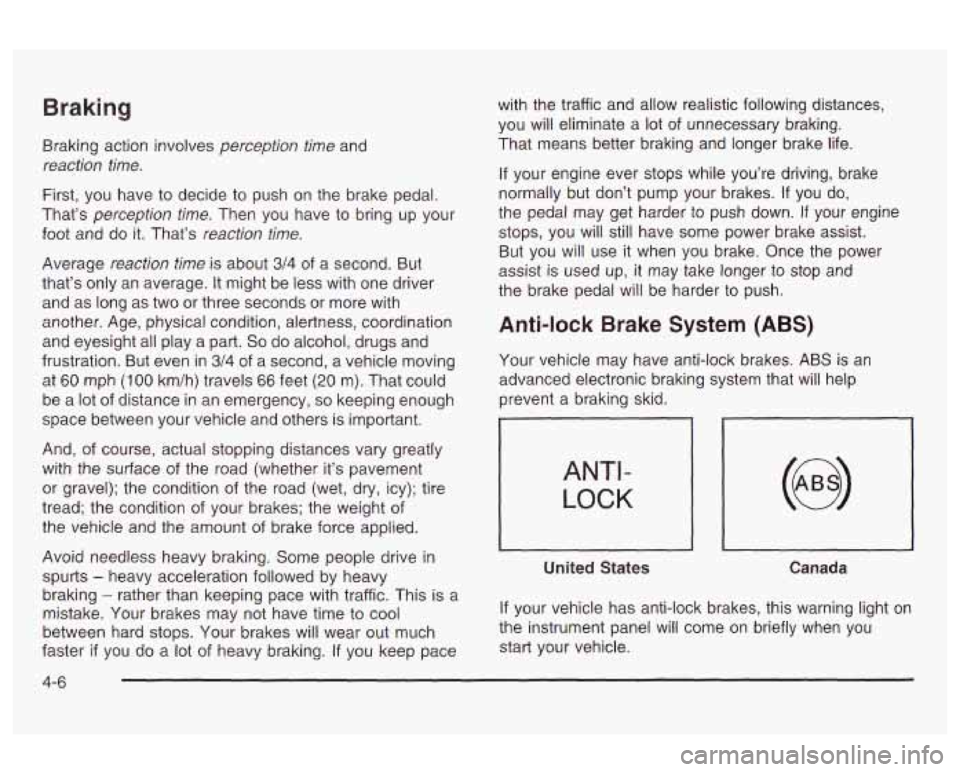
Braking
Braking action involves perception time and
reaction time.
First, you have to decide to push on the brake pedal.
That’s
perception time. Then you have to bring up your
foot and do it. That’s
reaction time.
Average reaction time is about 3/4 of a second. But
that’s only an average. It might be less with one driver
and as long as two or three seconds or more with
another. Age, physical condition, alertness, coordination
and eyesight all play a part.
So do alcohol, drugs and
frustration. But even in
3/4 of a second, a vehicle moving
at
60 mph (1 00 km/h) travels 66 feet (20 m). That could
be a lot
of distance in an emergency, so keeping enough
space between your vehicle and others is important.
And, of course, actual stopping distances vary greatly
with the surface of the road (whether it’s pavement
or gravel); the condition of the road (wet, dry, icy); tire
tread; the condition of your brakes; the weight of
the vehicle and the amount
of brake force applied.
Avoid needless heavy braking. Some people drive in
spurts
- heavy acceleration followed by heavy
braking
- rather than keeping pace with traffic. This is a
mistake. Your brakes may not have time to cool
between hard stops. Your brakes will wear out much
faster
if you do a lot of heavy braking. If you keep pace
with the traffic and allow realistic following distances,
you will eliminate a lot of unnecessary braking.
That means better braking and longer brake life.
If your engine ever stops while you’re driving, brake
normally but don’t pump your brakes.
If you do,
the pedal may get harder to push down.
If your engine
stops, you will still have some power brake assist.
But you will use
it when you brake. Once the power
assist is used
up, it may take longer to stop and
the brake pedal will be harder to push.
Anti-lock Brake System (ABS)
Your vehicle may have anti-lock brakes. ABS is an
advanced electronic braking system that will help
prevent a braking skid.
ANTI -
LOCK
United States
Canada
If your vehicle has anti-lock brakes, this warning light on
the instrument panel
will come on briefly when you
start your vehicle.
4-6
Page 180 of 354
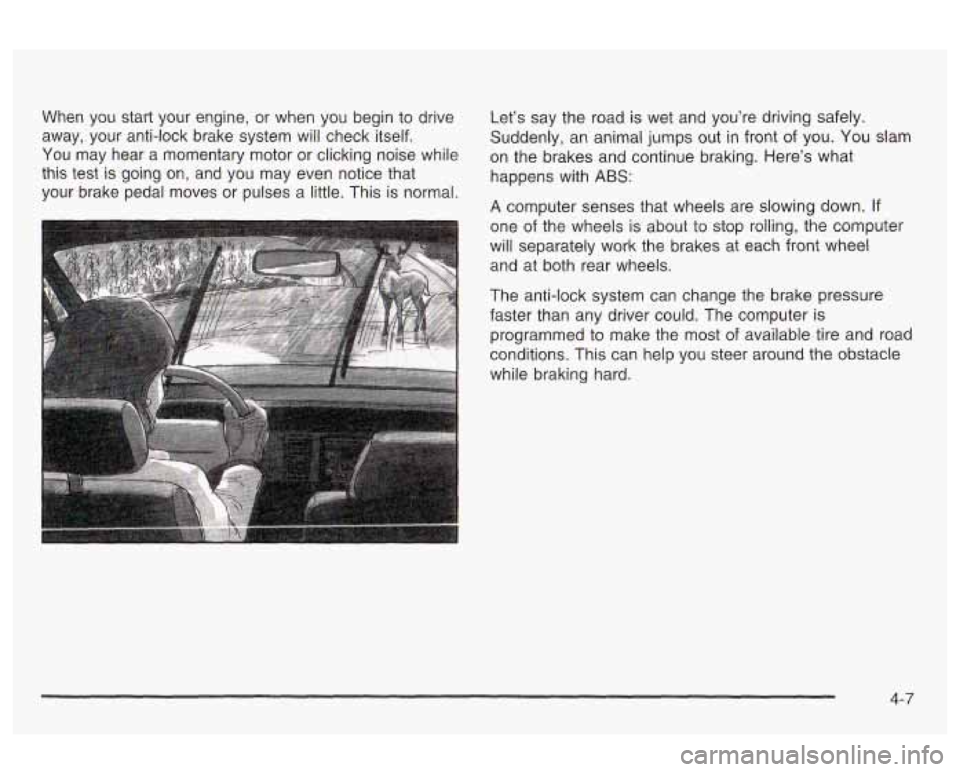
When you start your engine, or when you begin to drive
away, your anti-lock brake system will check itself.
You may hear a momentary motor or clicking noise while
this test
is going on, and you may even notice that
your brake pedal moves or pulses a little. This is normal. Let’s say the road
is wet and you’re driving safely.
Suddenly, an animal jumps out in front of you. You slam
on the brakes and continue braking. Here’s what
happens with ABS:
A computer senses that wheels are slowing down. If
one of the wheels is about to stop rolling, the computer
will separately work the brakes at each front wheel
and at both rear wheels.
The anti-lock system can change the brake pressure
faster than any driver could. The computer is
programmed to make the most of available tire and road
conditions. This can help you steer around the obstacle
while braking hard.
4-7